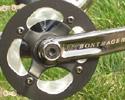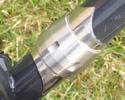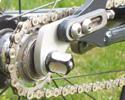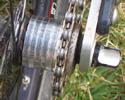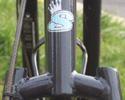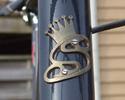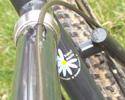
Recently on Cyclingnews.com |
On test: Sycip Diesel Singlespeed, Dec 31, 2007
Hand-built singlespeed perfection
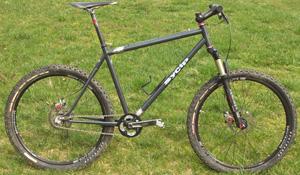
|
Bicycle technology continues to move forward at a meteoric pace. But despite all the high-end, carbon this-or-that, ultralight, superfast, aero, and blinged out bikes you can lay more than a month's salary on, the number of boutique frame builders continues to grow. Sonoma, California-based Sycip Bikes built Cyclingnews' Steve Medcroft a singlespeed to give us a peek into why the hand-built bicycle is still one the best ways for you to get the bike you really want.
Two years ago our Tech Editor, James Huang, attended a small trade show for custom framebuilders in San Jose, California. The North American Handmade Bicycle Show (NAHMBS) was a chance for custom frame shops to share ideas and look at the products and services that help them do their work. Not really knowing what to expect, or whether readers would find interest in us photographing and writing about what might have been completely unknown bike brands, we were hugely surprised by the show.
Every framebuilder brought their A-game bike; the show was filled with beautiful and ingenious hand-crafted works and inspiringly passionate people. You, the reader, seemed to be inspired by the stories and the work of these builders, clicking on the pages in record numbers and writing us letters. The coverage was so well received, we have made NAHMBS a fixed element of our editorial calendar (see 2007 show coverage). So why does a bicycle frame made from materials almost abandoned in the pro peloton, welded in a single-room shop in the back alley of some midsize town, resonate with cyclist's so much? Is it recognition of the place this type of bicycle manufacturing holds in the history of the sport? Is it the one-to-one relationship between you, your bike, and the guy who stitched it together? Is there an infusion of a builder's soul that defies the naked fact that a bike is just a pile of tubes welded together in a specific shape; an infusion you can feel when you ride? We thought that there was only one way to find out.
A history of Sycip
Sycip Bikes is the work product of two men; Jeremy and Jay Sycip. Jeremy is the principle framebuilder while Jay mostly manages the business. Both brothers attended Art Center College of Design, in Pasadena in the early nineties. Jeremy says he left school to take an apprenticeship with Northern California framebuilder Paul Sadoff at Rock Lobster. "We both liked riding bikes," Jeremy said. "I didn't have any fabrication or metalwork background - I just started calling around to smaller builders. Rock Lobster was a one-man shop in Santa Cruz and he took me in."
Sycip says his apprentice started with "cutting tubes and cleaning dropouts; things I didn't need a torch for." During his apprenticeship, Sycip attended a framebuilding course at the United Bicycle Institute (in Ashland, Oregon). With the experience of building his first bike in the course and more tutelage from Sadoff, Sycip says he branched out on his own in 1992. "I was waiting for my brother to get out of school," he said about the timing. "I still worked for Paul at first - for maybe four years - while we started our business. And our first bikes were all for friends and whatever clients we could find."
Sycip Bikes grew slowly. "We really didn't have a vision to create a big company," Jeremy says. "We just really enjoyed building bikes and loved when someone rode on one of our bikes and actually enjoyed it." The company, now fifteen years old, grew mostly through word of mouth. "We also sponsored racers early on. We actually had a local team that rode with our name on the jerseys and rode on our bikes in road and mountain bike races."
Today, Sycip is still a small shop. "It's just me and Jay," Jeremy says. "And I'm still the only framebuilder. We work with steel, aluminum, titanium. And on a lot of our road bikes, we use carbon back ends on steel or aluminum front ends." Sycip says he builds about 200 road, mountain, cross, track and travel bike frames and forks per year; a mix of one-off builds and small batches of standard-size frames in-between custom orders.
Getting our bike built
Since the tester is a longtime singlespeed rider, we settled on giving Sycip's Diesel singlespeed a try. The concept for our test bike was for it to be simple to put together, easy to maintain, and built with Sycip's S and S Machine couplings option (locking collars added to the frame that allow it to break down and be packed into airline-friendly travel cases).
Sycip's build process starts with a questionnaire. The form asks for body measurements (height, shoulder-to-shoulder width, thigh length, and more) as well as the pros and cons of our previous bikes. "Most people have something about an older bike that they want to tweak," Sycip says about how he uses the information on the form.
Sycip says he also wants to know what components a buyer plans to run, as well as any custom details (drivetrain component specs, powder coat color, continuous or standard cable-routing braze-ons, pump pegs, disc or v-brake mounts, etc.). "We also ask them about the kind of riding they plan to do; what they want the bike to do."
After discussing the answers on our form with Sycip, we settled on his standard Large frame geometry with continuous cable routing braze-ons, Pork Slider dropouts and the S and S couplings.
A close look at the build
When it arrived (about ten weeks later), we build up the frame with a mixture of components from Bontrager, Rock Shox/Avid and Chris King; a relatively top line and consistent known-quantity build that we hoped would allow us to feel the frame for its own merits. On went Bontrager's race Lite Tubeless wheels with Jones XC tires and Bontrager tubeless sealant, their carbon stem, seatpost and bars and Race X Lite MTB saddle. SRAM's marketing guru lent us a 100mm Reba SL and a complete set of Avid mechanical disc brakes and levers. Chris King kicked in their must-have No Threadset headset and supplied newly machined 16-tooth sprocket and spacers for the cassette-style hub on the Race Lite rear wheel. We bought a Race Face Evolve XC bottom bracket and a KMC chain at our local bike shop and hit the trails.
Close inspection of the frame during assembly revealed Sycip's welding style as on the artistic side of utilitarian - the bead is sturdy and present and human in it's lack of perfection but cleanly placed and everywhere it should be (and nowhere it should not be).
The finish, a dark gray/blue powder coat, was flawlessly executed. Sycip said he painted his very early frames but switched to powder coating because "the more we found out about powder, the more we wanted to use it. It is a more environmentally friendly way to paint a bike and is also a lot more durable." Sycip is so committed to powder coating in fact that three years ago, he bought out his local supplier; bringing the company employee total to three. "(Our supplier) wanted to get out of the business so it was an opportunity to pick up all the equipment, hire the painter, and bring the process in house."
The ride
We could tell Sycip's attention to his pre-build questionnaire had paid off the first time we threw a leg over the finished bike; the fit was perfect. The ride was also perfect; just because steel is the original frame material doesn't mean every frame builder knows exactly how the various tubing options should be put together in certain frame styles to make a confident yet comfortable ride but Sycip nailed it with our tester. The front-to-rear balance was right, the chain stays had plenty of beef for the torque of singlespeeding and the frame had enough up-and-down give (vertical compliance) to let you know this was a steel frame in all it's glory. The frame simply melted into the background during rides leaving only the the brain, body and trail all working together to produce that great high that can come from cycling.
As for our customized elements, the Paragon Machine Works sliders were a hit. Since the system mounts to the chain stays, there is no need for a tensioner or an eccentric bottom bracket for disc brake compatibility (frames with track-style horizontal dropouts, in which chain tension is adjusted by sliding the rear wheel into position and locking it with a tensioner, complicating the fixed-mounting positions needed for disc brakes). Once we set the tension and centered the wheel, the chain never once slipped. And (a fact that singlespeeders who carry 15mm spanners or Alan wrenches in their jersey pockets will appreciate) the Pork Slider design allows the use of quick release wheels.
The rest of the components were essentially trouble free although we had a little trouble getting the front disc caliper to sit perfectly straight and stop squealing and the combination of compression, rebound and motion control on the fork made dialing in ride comfort a trial-and-error effort.
All in all, we rode the bike a couple-dozen times over the course of a year in both wet and dry conditions and on the rooty, muddy terrain in Northern Virginia as well as the dusty and sometimes rocky trail systems in Northern California and Arizona. Over all, the frame showed no signs of fatigue - no change in ride characteristics, no cracks or corrosion - and the finish held up to all of our slovenly storage habits.
Splitting hairs
The only let down of the whole experience was the S and S machine works couplings. Not the couplings themselves mind you; they are ingenious additions to a bike frame that add little weight to the final frame (less than half a pound net gain) and had absolutely no negative effect on the handling of the bike (were undetectable in the ride as a matter of fact). The problem came when it was time to use the couplings as intended; to break the bike down for travel.
The concept behind the S and S machine collars is that with them installed in your frame, you can break your bike into pieces that will pack neatly into a case you can carry onto an airplane - thus avoiding the dreaded oversize baggage charge. Most airline specifications call for a maximum checked baggage size of 26-inch by 26-inch by 10-inches. There are numerous instructions online to show you how to lay pieces of your disassembled bike into such a case so it all fits. It's a three-dimensional puzzle; like one of those locking bent-nail sculptures you have to twist in just a certain way to get them apart. But no matter how we tried, regardless of which set of instructions we followed, all we got for our trouble when trying to pack the Diesel were a few scratches on the frame and pieces left out of the case.
One issue is that the fork was too long to fit in a 26-inch travel case no matter where in the pile of parts it went. The other problem seems to be, after much thought and speculation with a few experts, is that the dimensions of the rear triangle as built on our bike (it's width and the extra length added with the inclusion of the slider droupouts) threw off the delicate balance of how the bike pieces should all fit together.
Still, we were able to pack the fork and front triangle in a separate bag (leaving enough room in the 26x26x10-inch case for everything else to fit including shoes, water bottle, helmet and tools) and we did travel with the bike. Also, Jeremy Sycip says he was truly surprised we couldn't get our bike to fit in a travel case and offers that a new hard case available from Ritchey (a special folding-bike travel case that comes with an extra bubble of space on one side that may help the final wheel to fit into place in the stack) may have solved our problem. But our conclusion is that the S and S option was a disappointment. Although there are thousands of S and S equipped bikes that fit neatly in travel cases out there and maybe our experience was unique, we suggest that you make sure the bike you are building with S and S couplings is proven to break down and pack properly.
The wrap-up
There are a lot of choices if you're in the market to add a new bike to your stable. Before you simply eyeball the latest high-tech, mass-produced wonder bike cycling has to offer, consider a boutique builder like Sycip Bikes. Their Diesel is a well crafted and artfully finished singlespeed. Even though I rode a standard frame size, I got the custom treatment with my choice of options and finish and I ended up with a well balanced, durable and comfortable ride at a price that feels like a steal for work of this quality.
Price: USD$1,990 (frame only; with Paragon dropouts and S and S couplings
options)
Weight: 2.22 kg (4.9lb) (large frame, with couplings, without pedals)
Pros: Excellent craftsmanship, numerous customization choices, great
fit, sturdy but comfortable handling.
Cons: Equipped with S and S machine couplings, fully-built bike did not
break down into single travel case as expected.
More info: www.sycip.com
Cyclingnews rating: ![]()
Photography
For a thumbnail gallery of these images, click here
Images by Steve Medcroft / Cyclingnews
- Sycip's custom steel singlespeed frame, named the Diesel, decked out with components from Bontrager, Rock Shox, Avid and Chris King.
- Our test bike was equipped with Bontrager's Race Lite Tubless wheels
- Bontrager also provided a Race Lite Singlespeed crank
- The Paragon Machine Works Pork Slider' droupouts kept the drivetrain tight without the need for tensioners or an eccentric bottom brackets.
- Shimano's race-ready SPD's
- One of the two S and S machine couplings that allow the frame to split into two halves for travel.
- Pork Slider dropouts by Paragon Machine Works made wheel adjustment and chain tension setting easier than on anu singlespeed this tester has ridden.
- Chris King not only supplied the headset for our test bike, but the machined aluminum spacers and sprocket for the freewheel-hub on the Race Lite rear wheel
- The tread pattern on Bontrager's tubeless Jones XR tubeless tires provided plenty of all-around bite for the trail riding in our Northen Virginia and California excursions
- Jeremy Sycip says his wishbone design was an answer to the move from cantilever to v-brakes on mountain bikes in the early nineties.
- Bontrager's Race XXX Lite stem and 2007 Race X Lite MTB saddle.
- Chris King's No Threadset headset and Bontrager's Race XXX Lite OS Carbon stem and bars.
- A look at the front cap of the Race XXX Lite OS Carbon stem.
- Avid provided their FR-5 lever to match the mechanical disc brakes we used to stop the Sycip.
- The Sycip head badge; yes, a real head badge. Sycip moved from decals to proper headbadges early in his framebuilding career to give his bikes an extra touch. Add $50 to the price of your frame, and you can get your headbadge in sterling silver!
- The motion control lever on top of the Rock Shox Reba SL allowed shock tuning to handle the small bumps we encountered on trails in Northern Virginia, California and Arizona.
- The Rock Shox Reba SL can be ordered in 80mm or 100mm formats. We chose 100mm to give us the most felixibility with this simple bike intended to be durable and versatile to travel with.
- The entire front end; Race Lite Tubeless wheel, Jones XR Tubeless tires, Avid mechanical disc brakes and 100mm Rock Shox Reba fork.
- Initial tension adjustment is simple on Avid's mechanical disc brake.
- A close up look at the Paragon slider dropouts; a recommended option if you're considering a Sycip singlespeed of your own.
- The Paragan slider dropout made tension re-adjustment after initial setup a non-issue; the rear wheel never slipped and the chain never needed re-tensioning even after a dozed rides on the Sycip
- The S and S Machine collar that broke the down tube of the Sycip.
- The S and S Machine collar that split the top tube of the Sycip.
- Cable routing braze-ons that allowed us to remove and re-add the continuous brake cable routes without tearing the cable dompletely down were another option in Sycip's custom-build choices
Full Specification
|
Frame: Sycip Diesel singlespeed; Reynolds 725 tubing, Paragon Machine Works 'Pork Slider' dropouts, S and S Machine couplings Available sizes: XS, S, M, L (tested), XS |
Front brake: Avid mechanical disc brake |


